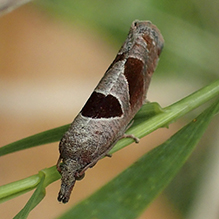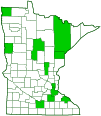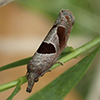triangle-backed pelochrista moth
(Pelochrista dorsisignatana)
Conservation • Description • Habitat • Ecology • Distribution • Taxonomy
|
||||||||
| Hodges # | 3116 |
|||||||
Conservation Status |
||||||||
| IUCN Red List | not listed |
|||||||
| NatureServe | NNR - Unranked SNR - Unranked |
|||||||
| Minnesota | not listed |
|||||||
Description |
||
Triangle-backed pelochrista moth is one of four closely related and similar moths that comprise the dorsisignatana species group or Pelochrista dorsisignatana section. Two of the four species, Pelochrista dorsisignatana and Pelochrista similiana, occur in Minnesota, They are easily distinguished by their markings. Triangle-backed pelochrista moth is a small, late season, leafroller moth. It occurs in the United States and southern Canada east of the Great Plains, in Colorado, and in British Columbia and Alberta Canada. Caterpillars feed on the roots, lower shoots, and emerging buds of Canada goldenrod and giant goldenrod. Adults are found in open and shaded areas with their host plants. They have been observed from July through November, but their peak occurrence is in August and September. Adults are ⅜″ (10 mm) in length and have a ½″ to ⅞″ (12 to 22 mm) wingspan. Females are slightly larger than males. Size is often given in terms of forewing length. The forewing length of females is ⅜″ to ½″ (8.8 to 11.4 mm), with a mean length of ⅜″ (9.9 mm). The forewing length of males is ¼″ to ½″ (6.6 to 11.5 mm), with a mean length of ⅜″ (9.3 mm). The antennae are long and thread-like. They are held straight back over the body when at rest. The finger-like sensory organs (palps) attached to the mouth are long and densely hairy. They are projected forward, appearing like a fuzzy snout. The head and palps are pale gray to reddish-brown, the same as the base color of the forewings. The forewings are narrower at the base and wider at the rear, giving the moth a tapered appearance. They are pale gray to reddish-brown and extensively overlayed with fine straight (striate) and wavy (vermiculate) lines. There are three prominent, reddish-brown to blackish-brown bands thinly outlined with white: a wide, oval band (subbasal band) extending from the forward one-third wing length to about the middle of the wing; a similarly sized, wide, oblique band (median band) extending rearward from near the leading edge (costal margin) just beyond the middle to the inner margin; and a narrow, oblique band (subterminal band) that begins at the inner (anal) angle at the end of the wing and extends inward. All of the bands are separated – the median band does not touch the subbasal band or the subterminal band. The median band fades as it approaches the costal margin and almost never reaches it. The subterminal band is much lighter and often breaks up before reaching the costal margin. There is no eyespot. The terminal band is dark with white, “salt-and-pepper” speckling. The hindwing is light brown to brownish-gray. |
||
Size |
||
Total length: ⅜″ (10 mm) Wingspan: ½″ to ⅞″ (12 to 22 mm) |
||
Similar Species |
||
Habitat |
||
Open and shaded areas with goldenrods |
||
Ecology |
||
Season |
||
August and September |
||
Behavior |
||
Adults are active at night and will come to lights. The wings are held tight to the body when at rest. |
||
Life Cycle |
||
The female lays eggs on a host plant stem close to the ground. When the eggs hatch, the larvae bore into the stem and tunnel down to the roots, where they spend the winter. |
||
Larva Hosts |
||
Canada goldenrod and giant goldenrod |
||
Adult Food |
||
|
||
Distribution |
||||
|
Sources |
|||
| 3/29/2023 | ||||
Occurrence |
||||
Common |
||||
Taxonomy |
|||
Order |
Lepidoptera (Butterflies and Moths) | ||
Superfamily |
Tortricoidea (tortricid leafroller moths and allies) | ||
Family |
Tortricidae (totricid leafroller moths) | ||
Subfamily |
Olethreutinae (olethreutine leafroller moths) | ||
Tribe |
Eucosmini | ||
Genus |
Pelochrista | ||
| Section | Dorsisignatana | ||
Genus Species |
|||
Synonyms |
|||
Carpocapsa distigmana Eucosma dorsisignatana Paedisca clavana |
|||
Common Names |
|||
triangle-backed eucosma moth triangle-backed pelochrista moth |
|||
Glossary
Costal margin
The leading edge of the forewing of insects.
Palp
Short for pedipalp. A segmented, finger-like process of an arthropod; one is attached to each maxilla and two are attached to the labium. They function as sense organs in spiders and insects, and as weapons in scorpions. Plural: palpi or palps.
Visitor Photos |
|||||
Share your photo of this insect. |
|||||
| This button not working for you? Simply email us at info@MinnesotaSeasons.com. Attach one or more photos and, if you like, a caption. |
|||||
Babette Kis |
|||||
Pelochrista dorsisignatana (triangle-backed pelochrista moth) |
|||||
 |
|||||
MinnesotaSeasons.com Photos |
|||||
|
|||||

Slideshows |
||

Visitor Videos |
|||
Share your video of this insect. |
|||
| This button not working for you? Simply email us at info@MinnesotaSeasons.com. Attach a video, a YouTube link, or a cloud storage link. |
|||
Other Videos |
|||

Created: 3/29/2023
Last Updated:


